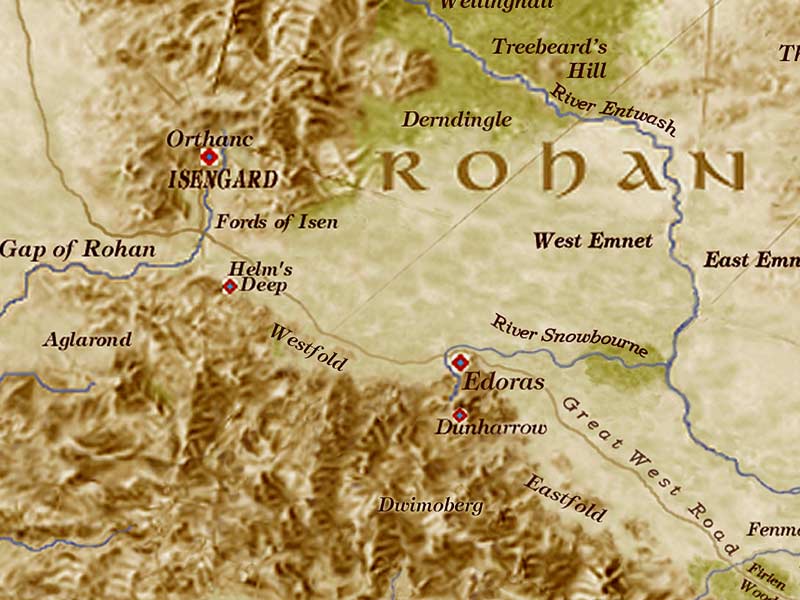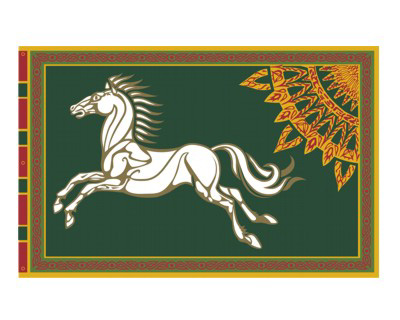Rohan
Geography
The countryside of Rohan is described as a land of pastures and lush tall grassland which is frequently windswept. It is similar to the Central Asian steppe, the North American Great Plains or the Argentine Pampas. The lands of Rohan are frequently described as appearing like "seas of grass", and are therefore perfect for horses (the word roch, in Sindarin, means a horse). At the time of the War of the Ring, Rohan was roughly a third the size of Gondor, whose borders had slowly been shrinking for centuries.

Its warm-continental climate generally brings hot summers and brisk but short winters, marking a midpoint between the harsh winters of Rhovanion and the long, subtropical summers of southern Gondor. Being near the centre of Middle-earth, the winds and air masses can come from almost any direction and the weather is highly variable in any season.
Borders
The borders of Rohan are: The rivers Isen and Adorn in the west, where Rohan borders Isengard and the land of the Dunlendings; the White Mountains and the Mering Stream, which separate it from Gondor, in the south; the mouths of Entwash in the east; and the river Limlight in the north.
Cities
The capital of Rohan is the hill fort of Edoras which lies close to the slopes of the White Mountains. Another large city is Aldburg, capital city of the Eastfold and original city of Eorl the Young. A third notable city is Snowbourne, named after the river which runs nearby it. It is similar in appearance to the hill-fort of Edoras. Dunharrow is a refuge in the White Mountains. Helm's Deep is a valley in the White Mountains in which the Hornburg, a major fortress of Rohan, is located.
Culture
The Dúnedain of Gondor and the Rohirrim were distantly related having descended from the Atanatári or Edain of the First Age, and the people of Gondor describe the Rohirrim as Middle Men, inferior to the Númenóreans in both culture and descent, but superior to the Men of Darkness who had worshipped and served Sauron and this is stated as fact in The Lord of the Rings, but contradicted in later writings.

In any case, they did not go to Beleriand like the Edain who were later rewarded with the island of Númenor by the Valar. The ancestors of the Rohirrim were known as the Éothéod and were given the province of Calenardhon by Gondor after the Battle of the Field of Celebrant.
The people of Rohan were tall, fair, pale, and mostly had blue eyes and blond hair which they wore long and braided. Almost all male Rohirrim wore beards. They were by nature stern, fierce and grave yet generous.
They are proud and willful, but they are true-hearted, generous in thought and deed; bold but not cruel; wise but unlearned, writing no books but singing many songs, after the manner of the children of Men before the Dark Years. The Lord of the Rings, The Two Towers
The Rohirrim had had contacts with Elves in their ancient history, and knew of Eru (God), but like the Dúnedain they did not worship him in any temples. They seem to have venerated the Vala Oromë the Hunter, whom they called Béma.
In response to a query about clothing styles in Middle-earth, Tolkien wrote:
The Rohirrim were not "medieval", in our sense. The styles of the Bayeux Tapestry (made in England) fit them well enough, if one remembers that the kind of tennis-nets [the] soldiers seem to have on are only a clumsy conventional sign for chainmail of small rings.
Horses and warfare
The Rohirrim were famous as skilled cavalry and breeders.
The armies of Rohan were almost exclusively horsemen, divided into irregular units termed éoreds, which could include up to 2,000 riders. Rohan's armies were more of a very well-trained militia called upon in times of war, with the actual standing army relatively small. They are described as armed with long spears, longswords, light helms, round shield, and mail armour.
In time of war, every able man was obliged to join the Muster of Rohan. They were also bound by the Oath of Eorl to help Gondor in times of peril, and the latter asked for their aid through the giving of the Red Arrow. Also, the Rohirrim could be notified to aid Gondor by the lighting of the warning beacons of Gondor, a line of beacon fires on the White Mountains that were constantly manned. In times of war, the starting beacon at Amon Din would be lit, until the last one could be noticed in Edoras.
Among the horses of the Rohirrim were the famed mearas, the noblest and fastest horses who have ever roamed Arda; Felaróf was the greatest of all mearas.
It was because of the close affiliation with horses, both in war and peace, that they received their now famous name. Rohirrim (or more properly Rochirrim) is Sindarin for "Horse-lords," and Rohan (or Rochand) means "Land of the Horse-lords." These names were devised by Hallas, son of Cirion the Steward.
Language
The Rohirrim's language is Rohirric. It is, like many languages of Men, akin to Adûnaic, the language of the Edain, and therefore to the Westron or Common Speech.
The Rohirrim call their homeland the Ridenna-mearc, the Riddermark or Éo-marc, the Horse-mark, also simply the Mark and call themselves the Eorlingas, the Sons of Eorl. In the original Rohirric the name for their land is Lôgrad, with the element "lô-"/"loh-" corresponding to Anglo-Saxon "éo", horse.
Rohirric bears a similar relationship to Westron, the Common Speech of Middle-earth, as that of Old English to modern English, and so Tolkien rendered Rohirric names and phrases into Old English (English of the Anglo-Saxon period), just as the Common Speech is translated into English. Examples include words such as mearas (another Old English word for "horses", which survives into Modern English as "mares") and éored. Tolkien was a philologist, with a special interest in Germanic languages.
Many archaic Hobbit names bear similarities to Rohirric, since the ancestors of the Shire hobbits lived on the upper reaches of the Anduin, close to the ancestors of the Rohirrim, and there was apparently a good deal of linguistic cross-fertilization. The name Hobbit itself is believed to be derived from the Rohirric Holbytlan (hole builders). These names are also translations of the original Westron Kuduk (Hobbit) and Rohirric kûd-dûkan (hole dweller).
History
In the thirteenth century of the Third Age (T.A.), the Kings of Gondor made close alliances with the Northmen of Rhovanion, a people said in The Lord of the Rings to be akin to the Three Houses of Men (later the Dúnedain) from the First Age.
In the twenty-first century, a remnant tribe of such Northmen calling itself the Éothéod moved from the valleys of Anduin to the north west of Mirkwood, clearing out what remained of the recently defeated witch kingdom of Angmar, east of the Misty Mountains. While there, some dispute arose between them and the Dwarves over the treasure-hoard of Scatha the dragon.
Later, in 2509, Cirion the Steward of Gondor sent summons to the Éothéod for aid in throwing off a combined invasion of Men from the north east of Middle-earth, and Orcs from Mordor.
Eorl the Young, king of the Éothéod, answered the summons, and arrived unexpected at a decisive battle at the Field of Celebrant, routing the orc army, and then destroying it as it fled.
As a reward, Eorl was given the plains of Calenardhon, and he moved his kingdom there. This land had earlier been part of Gondor proper, but had been devastated by the plague of 1636, and the survivors to a large extent slain in the invasion mentioned above.
The first line of kings lasted for 249 years, until the ninth king Helm Hammerhand died. His sons had been killed earlier, and his nephew Fréaláf Hildeson began the second line of kings, which lasted until the end of the Third Age.
In 2758, Rohan was invaded by Dunlendings under Wulf, son of Freca, of mixed Dunland and Rohan blood. The King, Helm Hammerhand, took refuge in the Hornburg until aid from Gondor and Dunharrow (a refuge of the Rohirrim) arrived a year later and defeated the invaders.
It was soon after this that Saruman arrived and took over Isengard, and was welcomed as a strong ally, since it would take Rohan close to 200 years to recover its strength after the invasion.
In 3014, Saruman began using his influence to weaken the King, Théoden, as part of a campaign to invade or take over the kingdom. In 3019, he launched a great invasion of Rohan, with victory in the two first battles (at the Fords of Isen; Théoden's son, Théodred was killed during these attacks) and defeat at the Battle of the Hornburg, where the Huorns came to the aid of the Rohirrim.
On the heels of this victory, Théoden rode with an army to Minas Tirith and helped break its siege in the Battle of the Pelennor Fields, where he was slain. Éomer, the nephew of King Théoden, then took up the reign, beginning the third line. Éomer rode with the armies of Gondor to the Black Gate of Mordor and took part in the Battle of the Morannon against the forces of Sauron, who were defeated when the Ruling Ring was destroyed.
The rule of the Stewards of Gondor was then over. King Éomer and the new king of Gondor, Elessar, renewed their oath of alliance, and reaffirmed Cirion's grant of Calenardhon to the Rohirrim.
In the Fourth Age, Rohan remained in peaceful coexistence with the Reunited Kingdom. It became the site of routes where Elves migrated from their eastern kingdoms to Lindon to leave Middle-earth. A few remained behind to help in the reconstruction of Rohan. A Dwarven community developed in the caves of Helm's Deep, which became prosperous from its mining of precious materials.
Politics
Rohan was an absolute monarchy. The King led the army during wartime. The country was divided into districts, such as the Eastfold and the Westfold, led by Marshals, though it is not clear whether their functions extended beyond the purely military.
Alliance with Gondor
The alliance between Rohan and Gondor came into existence in the year 2510 of the Third Age. In that year the Easterlings launched a massive invasion of Gondor. The army of Gondor was defeated and trapped between the Limlight and the Celebrant. Gondor, which had always been on friendly terms with the different tribes of the Northmen, sent messengers to the closest tribe, the Éothéod. Although it was unlikely that the message calling for aid would come through, it did. Then Eorl the Young and his fierce Éothéod Riders unexpectedly took the field during the Battle of Celebrant and turned the tide in the favour of Gondor. As a reward Cirion, the Steward of Gondor, gave Eorl the depopulated province of Calenardhon for his people to settle, while fulfilling Gondor's need for a strong ally. The Oath of Eorl was sworn by both Cirion and Eorl. Neither nation has ever broken the alliance ever since. Rohan has gone through great lengths to fulfil their part of the treaty including sacrificing two of its heirs when Gondor was under threat from the Haradrim in 2885, when Fastred and Folcred, the twin sons of King Folcwine, were killed during the Battle of Crossings of Poros. King Théoden once again honoured the alliance in the Battle of the Pelennor Fields.
War with the Dunlendings
To the west of Rohan lived the Dunlendings, a native people who had been hostile against the Free Peoples for a long time. The Dunlending Wulf briefly usurped of the throne of Rohan during the long winter. Wulf was also the commander of the Dunlendings and led them on constant raids upon the towns and cities of Rohan.